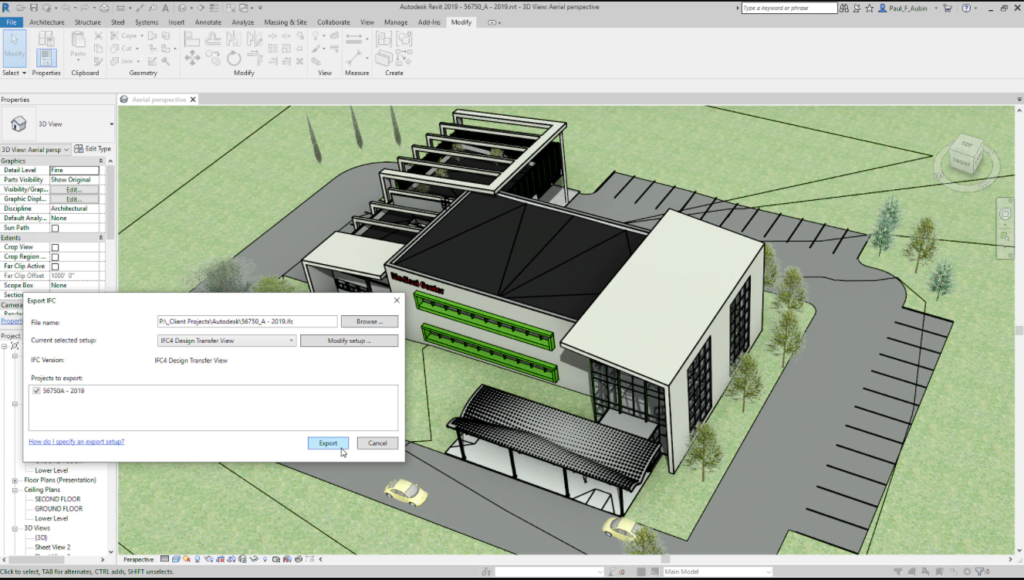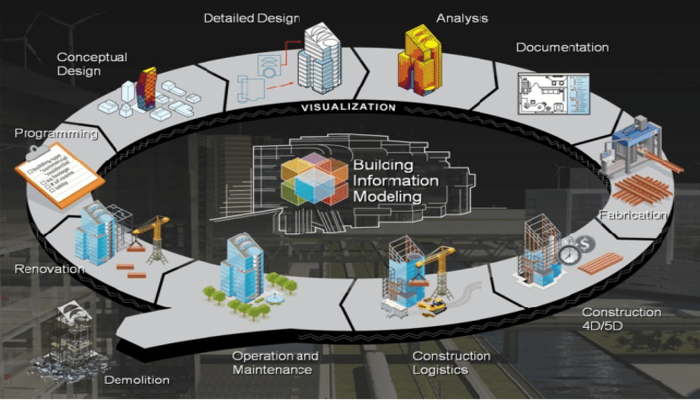
In today’s construction industry, experts are expected to do far more than manage schedules and budgets. They play a critical role in coordinating teams, resolving conflicts, and ensuring quality across every stage of a project.
Building Information Modeling (BIM) is not 3D; it is about controlling the whole life cycle of a construction process with the help of intelligent, digitalized representations. BIM in construction industry has rapidly evolved into a standard workflow, reshaping traditional ones into more collaborative and data-driven processes.
In fact, 70% of construction professionals have already implemented BIM, and another 18% intend to implement BIM shortly. This boom in usage indicates the level to which BIM has become essential in managing current construction issues.
The use of BIM in construction management is associated with improved planning, enhanced communication, and outcome control systems, enabling construction professionals to develop smarter, safer, and more efficient infrastructure.
Why Construction Management Professionals Should Learn BIM Software
Whether it is a residential tower or a mega infrastructure project, the compulsion to perform efficiently and accurately is immense. This is where BIM and construction come side by side.
This is the reason why professionals should consider BIM use in the construction industry:
1. Centralized Information
A workflow based on the BIM model construction enables all parties, including the architect and the contractor, to work collaboratively on a common platform. The fact that construction managers can access plans, updates, and revisions is an advantage when required and saves additional time.
2. Early Risk Detection
Using tools like Autodesk BIM 360 and Navisworks, managers may see if there are clashes in the design even before its implementation. This risk management is done proactively to minimize rework and aid in keeping schedules.
3. Seamless Coordination
Through the proper use of construction management with BIM tools, experts can fully ensure that what is in the design is what is carried out in the field. It simplifies the process of coordinating consultants, subcontractors, and vendors.
4. Improved Cost Management
BIM applications enable proper material estimates and resource plans. This will mean improved cost prediction and management, which are major aspects of construction management.
5. Better Career Opportunities
Organizations continue to seek employees who are well-versed in BIM technology in construction management. Professionals who know how to work on Autodesk project management software, such as Revit and BIM 360, are always wanted.
Top BIM Software For Construction Management Professionals
Here are the top 10 BIM construction management software tools that every professional should master:
1. BIM 360

BIM 360 is a comprehensive Autodesk project management software that streamlines issue tracking, RFIs, quality checks, and safety audits, and allows construction management teams to work effectively, minimizing mistakes and upholding the project standards throughout the process.
Use Case: This will be used in site inspection, control of subcontractors, and documentation in one of the single large construction projects in the country.
2. Autodesk Revit

Revit is the most popular BIM software for construction. It helps model architectural, structural, and MEP; its functionality provides strong documentation and design coordination. Learn Revit Today!
Use Case: This is best suited for examining elaborate construction models, creating schedules, and taking precise quantity takeoffs.
3. Autodesk Navisworks

Navisworks allows us to coordinate projects, detect clashes, and perform 4D simulations. Managers can watch model tire project models through the websites and identify the errors before they are taken to the construction site.
Use Case: A critical necessity for proper preconstruction planning, sequence of tasks and allocation of resources, and collaboration in multidisciplinary project teams.
Also checkout, top online navisworks courses in USA!
4. Tekla Structures

Tekla is well-represented as the best option for structuring modeling and has strong tools for producing precise steel and concrete designs. It simplifies elaborate fabrication practicalities and, therefore, is suitable for complicated construction projects involving precision and coordination efforts.
Use Case: Ideal in high-rises, bridges, and industrial works where the accuracy of the structure is a major concern.
Also Checkout top online courses to learn Tekla in USA.
5. Autodesk Civil 3D

Civil 3D is a high-power design application specifically focused on civil infrastructure work, where fast road planning, drainage, land grading, and site-building can be planned and modeled in dynamic data-driven processes and visualized.
Use Case: Enables construction managers to expediently pass on-site grading, alignment, and corridor modeling.
Also Checkout top online courses to learn Autodesk Civil 3d in USA.
6. Trimble

A cloud-based solution software enabling real-time access, updates, and collaboration on BIM models across teams, enhancing coordination, accelerating decision-making, and ensuring up-to-date project information throughout the construction lifecycle
Use Case: Enhances cooperation in the place of work and facilitates document management; all stakeholders will have access to the most recent project information in real-time.
7. Vectorworks Architect

This software provides versatile 2D and 3D modeling, which allows working efficiently on architectural design, filling in the gap between a creative idea and the practical implementation of construction, accuracy, and non-restrictive flexibility.
Use Case: Facilitates comparing the initial-phase architecture and on-site construction planning, enhances coordination, and minimizes the discrepancies between design and build.
8. Allplan

It can support architecture and civil engineering with highly effective modeling capabilities, comprehensive documentation of construction, and interdisciplinary work seamlessly, which will drive collaboration, precision, and efficiency at all stages of the project life.
Use Case: Best suited where precise documentation is to be made and where there are many disciplines to coordinate in a construction project.
9. ArchiCAD

ArchiCAD is recognized as one of the most efficient collaboration design tools as it corresponds with open BIM standards and offers rapid modeling ability.
Use Case: This is ideal for managers running design-build or integrated delivery jobs because of smooth coordination and implementation.
10. PlanGrid (Autodesk Construction Cloud)

PlanGrid helps construction managers store and work on blueprints, markups, photos, and punch lists in real-time, which enhances construction field communication, facilitates progress, and keeps all documentation up-to-date and accurate.
Use Case: Designed to be used on-site with real-time tracking of the tasks to be more efficient and accountable in the projects.
Where to Learn These Software Tools?
Knowing the top software is just the beginning. What matters is learning how to apply them in real-world construction scenarios. That’s where Novatr comes in, a future-forward platform offering construction management BIM software training tailored for civil engineers.
Novatr’s offers BIM Professional Course for Civil Engineers is specifically designed to help professionals like you gain mastery in digital construction. The course includes hands-on software training, real-world projects, and industry mentorship. Whether you’re aiming to lead digital site execution or grow into a BIM leadership role in top construction management firms, you can check out Novatr’s course to learn about BIM Curriculum, relevant software tools, and guidance from industry expert to kick start your BIM career.
Why Choose US?
- Trusted by Thousands: Join 6,000+ BIM learners from over 45 countries who have successfully graduated from Novatr.
- Expert-Driven Curriculum: Designed through the analysis of 1,000+ job descriptions and rigorously vetted by 200+ global BIM experts.
- Globally Recognized Certifications: Earn certifications from both Autodesk and Novatr, showcasing your verified expertise.
- Proven Career Impact: Learners report an average salary hike of 48% after course completion.
- Loved by BIM Learners: We have 4.6+ average rating across platforms like Google and Trustpilot.
In Conclusion
As the construction industry undergoes rapid digital transformation, adapting to BIM software for construction management is no longer optional; it’s essential. From Autodesk Revit and BIM 360 to Tekla Structures, these tools help professionals streamline workflows, reduce risks, and deliver high-quality projects on time and within budget.
For those in civil engineering, learning the Building Information Modeling (BIM) Professional Course for Civil Engineers provides a strong edge in today’s competitive job market. Exploring construction management with BIM tools not only enhances project performance but also unlocks new career opportunities and salary growth.
To start your BIM journey, visit Novatr and explore their industry-backed programs. Dive deeper into emerging trends and tools through our resource page.
The use of BIM in construction industry projects is reshaping how we plan, collaborate, and execute infrastructure worldwide. Those who adopt and lead this shift will not just follow the future, they’ll define it.
Was this content helpful to you



.jpg)




.jpg)


